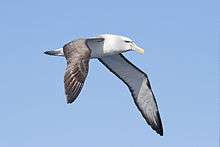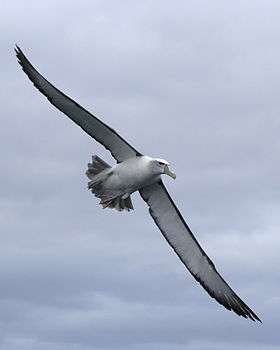Shy albatross
| Shy albatross | |
|---|---|
 | |
| Scientific classification | |
| Kingdom: | Animalia |
| Phylum: | Chordata |
| Class: | Aves |
| Order: | Procellariiformes |
| Family: | Diomedeidae |
| Genus: | Thalassarche |
| Species: | T. cauta |
| Binomial name | |
| Thalassarche cauta | |

The shy albatross or shy mollymawk (Thalassarche cauta) is a medium-sized albatross that breeds on three[3] Australian islands and ranges across the southern Indian Ocean.
Some authorities call this species the white-capped albatross.[4]
Taxonomy
This mollymawk was once considered to be the same species as the Salvin's albatross, Thalassarche salvini and the Chatham albatross, Thalassarche eremita, but they were split around 2004. In 1998, Robertson and Nunn suggested a four-way split including the white-capped albatross, Thalassarche steadi.[5] The three-way split was accepted by Brooke in 2004,[6] the ACAP in 2006,[7] SACC in 2008,[8][9][10] and BirdLife International by 2000.[11] James Clements was the last major holdout on the three-way split[12] but later accepted it.[13] The fourth split, steadi, was only accepted by the ACAP in 2006,[7] and BirdLife International in 2008.[11] Finally, following Brooke, this species was shifted from Diomedea to Thalassarche, which was generally agreed upon by most experts.
Mollymawks belong to the albatross family, Diomedeidae, which shares the order Procellariiformes with shearwaters, fulmars, storm petrels, and diving petrels. Procellariiformes have certain identifying features. They have nasal passages that attach to the upper bill, called naricorns (although the nostrils on the albatross are on the sides of the bill). The bills are also unique in that they are split into between seven and nine horny plates. They produce a stomach oil made up of wax esters and triglycerides that is stored in the proventriculus. This is used against predators as well as an energy-rich food source for chicks and for the adults during their long flights.[14] They also have a salt gland that is situated above the nasal passage and helps desalinate their bodies, required due to the high amount of ocean water that they imbibe. It excretes a high saline solution from their nose.[15]
Description
The shy albatross averages 90 to 99 cm (35–39 in) in length, 220 to 256 cm (87–101 in) wingspan,[16] and 4.1 kg (9.0 lb) in weight. Alongside its similarly sized sister species, the Salvin's albatross, this species is considered the largest of the mollymawks or the small albatrosses.[17][18] It is a black, white and slate-grey bird with the characteristic black thumb mark at the base of the leading edge of the underwing. Adults have a white forehead and a crown, which is bordered on the bottom with a dark eyebrow and pale grey face. Its mantle, tail and upperwing are grey-black, and the rest is white. Its bill is grey-yellow with a prominent yellow culmen and yellow tip.[19]
Behavior

Feeding
The shy albatross feeds by a combination surface-seizing and some pursuit diving – it has been recorded diving as deep as 5 m (16 ft). Fish, cephalopods, crustacea, and tunicates are the sustenance for this species.[20]
Reproduction
The shy albatross breeds on rocky islands and builds mounded nests of soil, grass, and roots. They lay one egg in the second half of September.[6]
Range and habitat
| Location | Population | Date | Trend |
|---|---|---|---|
| Albatross Island | 5,017 pairs | 2007 | Increasing 3% per yr |
| Mewstone | 7,258 — 7,458 pairs | 1996 | |
| Pedra Branca | 268 pairs | 1996 | Decreasing 10% per yr |
| Total | 26,000 | 2007 | Unknown |
The shy albatross is endemic breeder to Australia and it breeds on three island colonies; Albatross Island, Pedra Branca, and the Mewstone.[21] During the breeding season, adults concentrate around southern Australia and Tasmania.[22][23][24][25] Juvenile birds are known to fly as far as South Africa;[24][25] otherwise, non-breeding birds can be found throughout the southern oceans, but specifics are hard to determine due to their similarity to the other species.[7][26] It is sometimes found off the Pacific coast of the United States.
Conservation
The IUCN classifies this species as near threatened,[27] with an occurrence range of 23,900,000 km2 (9,200,000 sq mi). The population from an estimate in 2007 was 25,500 breeding birds with 5,100 pairs on Albatross Island, 270 pairs on Pedra Branca, and 7,380 on the Mewstone.[19] Historically, they were exploited for their feathers, and by 1909 there were only 300 pairs left on Albatross Island.[6][28]
Today, longline fishing still impacts this species but their numbers have been maintained despite this threat.[25] They also had an avian pox outbreak on Albatross Island that has impacted their numbers slightly.[29] Finally, the Australasian gannet, Morus serrator is the primary threat to their survival.[7]
Footnotes
- ↑ BirdLife International (2016). "Thalassarche cauta". The IUCN Red List of Threatened Species. IUCN. 2016: e.T22729604A95019083. doi:10.2305/IUCN.UK.2016-3.RLTS.T22729604A95019083.en. Retrieved 13 December 2017.
- ↑ Brands, S. (2008)
- ↑ eprints.utas.edu.au/14711/1/front-Alderman-thesis.pd
- ↑ Remsen Jr., J. V. (2008)(a)
- ↑ Robertson, C. J. R. & Nunn, G. B. (1998)
- 1 2 3 Brooke, M (2004)
- 1 2 3 4 ACAP (2006)
- ↑ Remsen Jr., J. V. (2004)
- ↑ Remsen Jr., J. V. (2005)
- ↑ Remsen Jr., J. V. (2008)
- 1 2 BirdLife International (2008b)
- ↑ Clements, J. (2007)
- ↑ Clements, J. F., T. S. Schulenberg, M. J. Iliff, D. Roberson, T. A. Fredericks, B. L. Sullivan, and C. L. Wood. 2016. The eBird/Clements checklist of birds of the world: v2016. Downloaded from http://www.birds.cornell.edu/clementschecklist/download/
- ↑ Double, M. C. (2003)
- ↑ Ehrlich, Paul R. (1988)
- ↑ Dunn, Jon L. & Alderfer, Jonathan (2006)
- ↑ "Save the albatross: Shy albatross". The RSPB.
- ↑ Brooke, Michael, Albatrosses and Petrels across the World (Bird Families of the World). Oxford University Press (2004), ISBN 978-0-19-850125-1
- 1 2 3 BirdLife International (2008a)
- ↑ Hedd, A. & Gales, R. (2001)
- ↑ Brothers, Nigel (2001). Tasmania's Offshore Islands: seabirds and other natural features. Tasmanian Museum and Art Gallery. ISBN 0-7246-4816-X.
- ↑ Hedd, A., et al. (2001a)
- ↑ Garnett, S. T. & Crowley, G. M. (2000)
- 1 2 BirdLife International (2004)
- 1 2 3 Baker, G. B., et al. (2007)
- ↑ Double, M. C. , et al. (2003)
- ↑ BirdLife International (2012). "Thalassarche cauta". IUCN Red List of Threatened Species. Version 2013.2. International Union for Conservation of Nature. Retrieved 26 November 2013.
- ↑ Johnstone, G. W., et al. (1975)
- ↑ Woods, R. & Gales, R. (2008)
References
- ACAP (2007). "ACAP species assessments, Shy Albatross" (pdf). ACAP. Retrieved 20 Feb 2008.
- Alsop III, Fred J.(2001). Smithsonian Birds of North America. Dorling Kindersley ISBN 0-7894-8001-8
- Baker, G. B.; Double, M. C.; Gales, R.; Tuck, G. N.; Abbott, C. L.; Ryan, P. G.; Petersen, S. L.; Robertson, C. J. R.; Alderman, R. (2007). "A global assessment of the impact of fisheries-related mortality on Shy and White-capped Albatrosses: conservation implications". Biological Conservation. 137: 319–333. doi:10.1016/j.biocon.2007.02.012.
- Tracking ocean wanderers the global distribution of albatrosses and petrels (PDF). Global Procellariiform Tracking Workshop, 1–5 September 2003, Gordon's Bay, South Africa. Cambridge, U.K.: BirdLife International. 2004. ISBN 0-946888-55-8.
- BirdLife International (2008a). "Bartlett's Tinamou – BirdLife Species Factsheet". Data Zone. Retrieved 18 Feb 2009.
- BirdLife International (2008b). "The BirdLife checklist of the birds of the world, with conservation status and taxonomic sources" (xls). Retrieved 18 Feb 2009.
- Brands, Sheila (Aug 14, 2008). "Systema Naturae 2000 / Classification – Diomedea subg. Thalassogeron –". Project: The Taxonomicon. Retrieved 18 Feb 2009.
- Brooke, M. (2004). "Procellariidae". Albatrosses And Petrels Across The World. Oxford, UK: Oxford University Press. ISBN 0-19-850125-0.
- Clements, James (2007). The Clements Checklist of the Birds of the World (6th ed.). Ithaca, NY: Cornell University Press. ISBN 978-0-8014-4501-9.
- Double, M. C. (2003). "Procellariiformes (Tubenosed Seabirds)". In Hutchins, Michael; Jackson, Jerome A.; Bock, Walter J.; Olendorf, Donna. Grzimek's Animal Life Encyclopedia. 8 Birds I Tinamous and Ratites to Hoatzins. Joseph E. Trumpey, Chief Scientific Illustrator (2nd ed.). Farmington Hills, MI: Gale Group. pp. 107–111. ISBN 0-7876-5784-0.
- Double, M. C.; Gales, R.; Reid, T.; Brothers, N.; Abbott, C. L. (2003). "Morphometric comparison of Australian shy and New Zealand white-capped albatrosses". Emu. 103: 287–294. doi:10.1071/mu03012.
- Dunn, Jon L.; Alderfer, Jonathon (2006). "Albatrosses". In Levitt, Barbara. National Geographic Field Guide to the Birds of North America (fifth ed.). Washington D.C.: National Geographic Society. p. 80. ISBN 978-0-7922-5314-3.
- Ehrlich, Paul R.; Dobkin, David, S.; Wheye, Darryl (1988). The Birders Handbook (First ed.). New York, NY: Simon & Schuster. pp. 29–31. ISBN 0-671-65989-8.
- Garnett, S. T.; Crowley, G. M. (2000). The action plan for Australian birds 2000. Canberra, Australia: Environment Australia.
- Hedd, A. (1999). Foraging ecology of Shy Albatrosses (Thesis).
- Hedd, A.; Gales, R.; Brothers, N. (2001a). "Foraging strategies of Shy Albatross Thalassarche cauta breeding at Albatross Island, Tasmania, Australia". Marine Ecology Progress Series. 224: 267–282. Bibcode:2001MEPS..224..267H. doi:10.3354/meps224267.
- Johnstone, G. W.; Dorwood, D. F. (1975). "The White-capped Albatross of Albatross Island: numbers and breeding behaviour". Emu. 75: 1–11. doi:10.1071/mu9750001.
- Remsen Jr., J. V.; et al. (Dec 2004). "Proposal #155 to South American Check-list Committee: Split Shy Albatross Thalassarche cauta into two or three species". South American Classification Committee. American Ornithologists' Union. Archived from the original on 2008-05-16. Retrieved 18 Feb 2009.
- Remsen Jr., J. V.; et al. (Feb 2005). "PROPOSAL (#166) TO SOUTH AMERICAN CLASSIFICATION COMMITTEE: RE-LUMP THALASSARCHE EREMITA AND THALASSARCHE SALVINI WITH THALASSARCHE CAUTA". South American Classification Committee. American Ornithologists' Union. Archived from the original on 2008-05-08. Retrieved 18 Feb 2009.
- Remsen Jr., J. V.; et al. (28 Feb 2008). "Proposal (#255) to South American Classification Committee : Follow-up to Proposal 155: Split Thalassarche cauta into three species". South American Classification Committee. American Ornithologists' Union. Archived from the original on 2008-05-16. Retrieved 18 Feb 2009.
- Remsen Jr., J. V.; et al. (28 Feb 2008). "A classification of the bird species of South America : South American Classification Committee American Ornithologists' Union". South American Classification Committee. American Ornithologists' Union. Archived from the original on 2009-03-02. Retrieved 18 Feb 2009.
- Robertson, C. J. R.; Nunn, G. B. (1998). "Towards a new taxonomy for albatrosses". In Robertson, G.; Gales, R. Albatross biology and conservation. Chipping Norton, Australia: Surrey Beatty & Sons. pp. 13–19.
- Woods, R. & Gales, R. (2008), in litt.
External links
| Wikispecies has information related to Thalassarche cauta |

- Shy Albatross - Species text in The Atlas of Southern African Birds.
